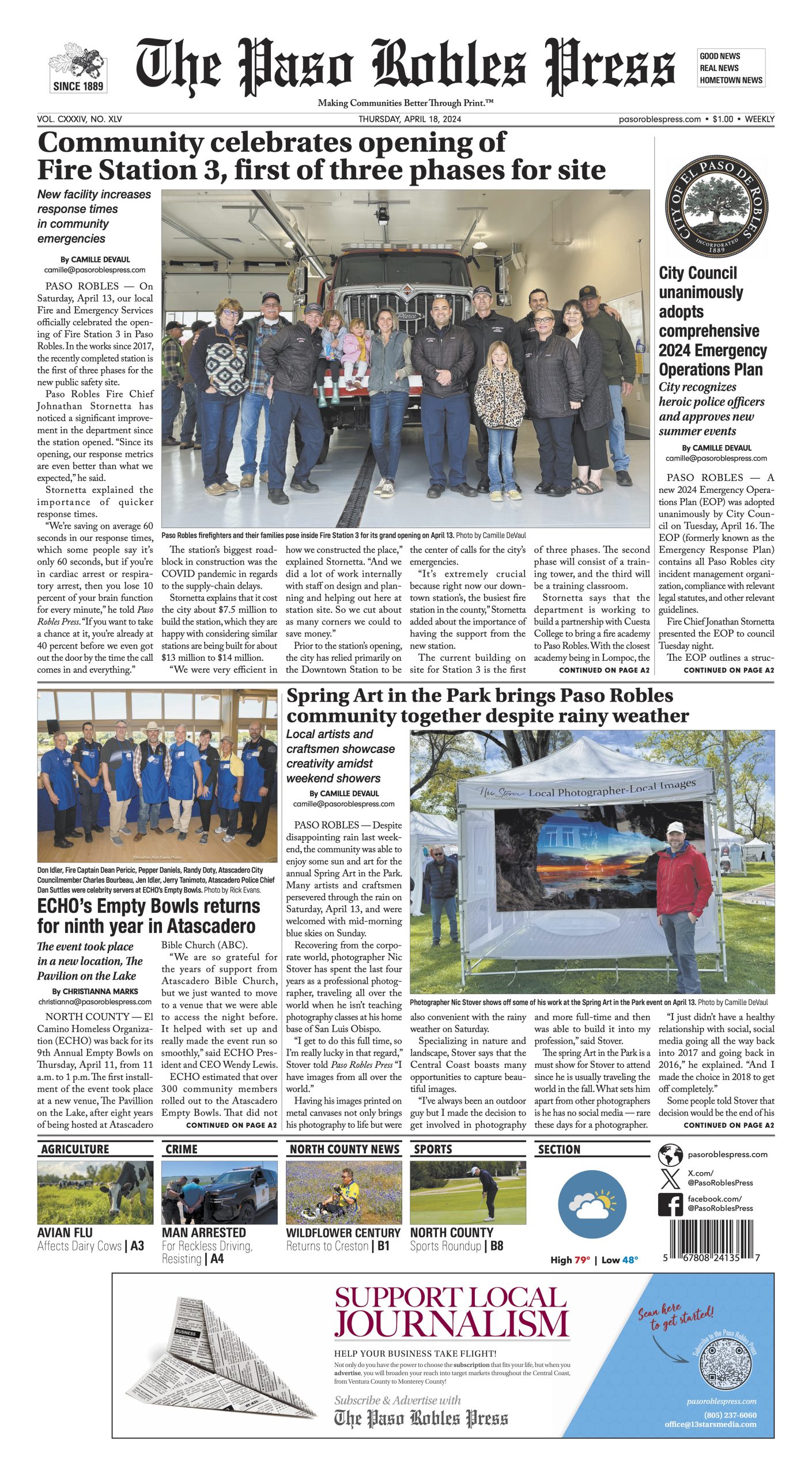Marijuana, Jail Deaths, Chip Seal, and Big Sur
Hampering Hemp: I’m a sixties survivor, but I never did drugs, as difficult as that is to believe. I’d love to tell you it was my superior moral character and willpower but the truth is more mundane.
When I was 13, for two miserable weeks I had the flu from hell. Wracked with delirium from a high fever, I watched the walls grow bumps, the room became fisheye distorted. I begged it to stop. It was the ultimate bad trip and it spooked me from anything remotely mind-altering forever.
Obviously my generation feels differently and their diligence finally paid off—for them, at least—because because they can soon blaze away without fear of the po-po, now that recreational pot is legally legit.
San Luis Obispo County isn’t quite as sanguine.
Proposition 64 requires local government to have in place the rules for pot sales, growing and distribution by January 1, 2018, and with the county board of supervisors’ realization that three quarters of 2017 have expired, board members and staffers are scrambling to write the necessary ordinance in time to user in the brave new world of legal rec-pot.
First on the agenda is cost: $1.2 million to regulate weed’s supply and sales chain and that means taxes. Tariffs being discussed range from a modest 3% up to a cigarette-stiff 20% to cover some 48 pages of proposed ordinances county officials deem necessary to keep the genie in control, if not in the bottle. By the way, those are just the county’s proposed taxes, to be added to the state’s rec-pot fees. While blazing will be legal, it won’t be cheap.
Pot users may also breathe a coughing, blue sigh of relief because board members so far agree the pot tax shouldn’t become a new revenue windfall to cover every unfunded item on their Santa list.
The battle over where pot can be grown and under what rules, is likely to be the biggie. I won’t rehash the woes of current pot growers in the California Valley because alternative news and the mainstream local media have more than adequately come to their aid, shouting angrily about due process violations. County lawsuits seek to shut down several area pot farms, giving growers a pretty good view of local government’s adversarial take on their endeavors.
California Valley, aptly-named epicenter—not just for its seismic proclivities, but its isolated, quiet, counter-culture reputation of being a quiet, out-of-view cannabis oasis—attracted the pot pioneers. Yet California Valley is no oasis; the desert valley has no real water supplies, other than an easily over-drafted groundwater basin.
Hundreds of potential pot growers lustily eye the area, and that has county officials worried about water; they’re mulling a total ban on pot grows in this northwestern portion of Carissa Plain, bordered by rolling hills, mountains and an alkaline lake. In fact, county environmental health officials say the water is poor, salty and shallow. Look for county supervisors and planners to hash out those restrictions in August, carefully sharpening their regulatory pencils, seeking public opinion for their response to California’s cynically-named Medicinal and Adult Use Cannabis Regulation and Safety Act.
Jail Deaths: Shortly after the 11th inmate to die in county custody since 2012 was reported, county officials signed a settlement for $5 million for the wrongful death of Andrew Holland. Holland, who reportedly suffered from schizophrenia, had been strapped in a special chair used at the jail to restrain prisoners, for 46 hours. Holland’s death was ruled the result of a blood clot.
District Attorney Dan Dow confirms the number of deaths in county jail, since 2012, and now the FBI is actively investigating.
San Luis Obispo County Jail is part of the Sheriff’s Department. There have been public calls for Sheriff Ian Parkinson’s ouster, but it was Parkinson who requested the FBI’s involvement. The time frame for completion of that investigation is open-ended but the results of that inquiry will be turned over to the U.S. Justice department’s civil rights division.
Chip Job: Question: what looks like new pavement but isn’t? Chip-seal, a hot tar and gravel top coat job reminiscent of sixty-something someone after a $300 spa treatment; they look vastly improved but the deeper bumps and undulations haven’t gone away.
Actually, the work is more than cosmetic; a chip seal coat covers small cracks and bumps, preventing water from seeping under the roadway and causing the road base to deteriorate. A new top coat can extend pavement life and ultimately saves money.
The county-wide road resurfacing project has gotten underway and covers a number of secondary roads in the North County.
So after that pep talk, you’ll feel a lot better when crews along Spanish Camp, Barley Grain, Vineyard and Chimney Rock roads make you stop for flagmen and women when you’re already late for work. No? At least there’s comfort in the fact the $1.5 million spruce up will be done by mid September.
Slide Stops: Hwy 1 to Big Sur may reopen sooner than previous pessimistic predictions promised, and if that many alliterations doesn’t have you smiling, how about a new road, not through the Mud Creek slide area but over it?
In fact, Caltrans may beat their prediction of a year or more before Hwy 1 reopens, because geologists now believe the massive, 7 million cubic yard rockslide along the southern reaches of the Monterey Coast, has stopped moving. That is the benchmark Caltrans was looking for, before road repairs begin.
The state transit agency now believes that the road can be reopened, not through, but on top of the biggest slide in the area’s history, without excavating the site. The road will run along the top, stabilized, “with a series of embankments, berms, rocks, netting, culverts and other stabilizing material,” according to Caltrans.
Actual time frame? None yet, but businesses and tourists will surely return, because a drive along the Big Sur coastline will always be the best high there is.










